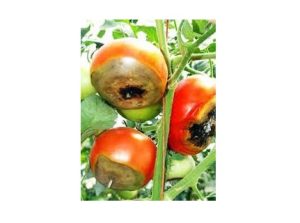A favorite fruit to grow in the summer, especially in the sunny Mother Lode, is the tomato. Tomatoes do need vigilant care, as the crop is susceptible to pests and diseases. To avoid problems, choose disease-resistant cultivars whenever possible. Also, note that tomato plants will be more susceptible to soil-borne disease and rot if not kept off the ground with a stake or other support system.
While checking your tomatoes for ripeness you may run across some that have an odd brownish- black area right on the bottom where the blossom ends. If so, you probably have blossom end rot. This disorder not only affects tomatoes, but also squash, eggplants and peppers. For this article, we will focus on tomatoes.
This is a physiological disorder, not a parasitic attack or viral disease. This means that it is caused by environmental conditions. It will not spread from fruit to fruit or from plant to plant. You can begin to remedy these conditions right away, but there is nothing you can do with the affected fruit other than to pick and discard it. Hopefully, this will not make a large dent in your overall tomato harvest.
The primary cause of blossom end rot is irregular watering and not enough calcium in the soil, but there are more precautions you can take before you even put the plants in the ground to improve your chances for healthy abundant fruit, free from the end rot.
Make sure that your soil drains well and is adequately aerated. Do not plant tomato plants until the soil temperature is at least 55 degrees. You can use a soil thermometer to check your soil temperature. Then, check the PH of your soil. A PH of 6.2 – 6.8 is best. Add a balanced fertilizer that is low in nitrogen such as 4-12-4 0r 5-20-5. Ground eggshells added to soil well before planting can give your plants a calcium boost. Too much nitrogen can make the calcium in the soil less available. Once planted, mulch well and do not disturb the root area with vigorous weeding. Irregular watering can also trigger the blossom end rot. Water regularly and consistently. It is also wise to cover tomato plants with shade cloth during windy or hot days.
The varieties more prone to blossom end rot include San Marzano, Orange Banana and Better Boy. Avoid these varieties if you have had blossom end rot problems. Take all these precautions and you will not likely have the end rot.
For more information, these sites are helpful:
http://ipm.ucanr.edu/PMG/GARDEN/VEGES/ENVIRON/blossomendrot.html
http://vegetablemdonline.ppath.cornell.edu/factsheets/Tomato_BlossRt.htm
https://catalog.extension.oregonstate.edu/sites/catalog/files/project/pdf/fs139.pdf
Wendy Kubow is a University of California Cooperative Extension Master Gardener of Calaveras County. UCCE Master Gardeners of Tuolumne and Calaveras Counties can answer home gardening questions. Call 209-533-5912 or fill out our easy-to-use problem questionnaire here. Check out our website here, You can also find us on Facebook.

